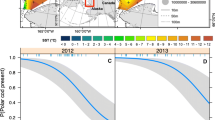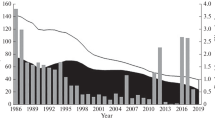Abstract
This study used a delta-lognormal model to analyze monthly catches of age-0 Pacific bluefin tuna by the troll fishery. The model included fixed effects of month, area, and month–area interaction, and random effects of port, year and port–year interaction. The catch patterns by month and area predicted by the statistical model (standardized catch) revealed that main fishing grounds along the Tsushima Warm Current generally shifted from north to south as the season turned from autumn to winter. In contrast, the standardized catch along the Kuroshio Current did not show such clear spatiotemporal patterns. The standardized catch along the Tsushima Warm Current is significantly associated with average monthly sea surface temperatures in the fishing grounds and consistent with migration routes revealed by tagging experiments in previous studies. These associations indicate the spatiotemporal catch pattern in the Tsushima Warm Current region partly reflects seasonal migration. Knowledge of the possible associations among fish migration, environmental factors and spatiotemporal distribution of the catch will contribute to future management of this species.







Similar content being viewed by others
References
Ichinokawa M, Coan AL, Takeuchi Y (2008) Transoceanic migration rates of young north Pacific albacore, Thunnus alalunga, from conventional tagging data. Can J Fish Aquat Sci 65:1681–1691
Kurota H, McAllister MK, Lawson GL, Nogueira JI, Teo SLH, Block BA (2009) A sequential Bayesian methodology to estimate movement and exploitation rates using electronic and conventional tag data: application to Atlantic bluefin tuna (Thunnus thynnus). Can J Fish Aquat Sci 66:321–342
Bayliff WH (1994) A review of the biology and fisheries for northern bluefin tuna, Thunnus thynnus, in the Pacific Ocean. FAO Fish Tech Pap 336:244–295
Itoh T (2004) A study on migration ecology of Pacific blufin tuna. PhD dissertation, University of Tokyo, Tokyo (in Japanese)
Yamada H, Takagi N, Nishimura D (2006) Recruitment abundance index of Pacific bluefin tuna using fisheries data on juveniles. Fish Sci 72:333–341
Yamada H, Yamamoto K, Nitta A (2007) Estimation of annual bluefin tuna catch in weight by the troll fishery in Nagasaki prefecture, based on the Japanese official fisheries statistics. Bull Jap Soc Fish Oceanogr 71:122–130 (in Japanese with English abstract)
Koido T, Mizuno K (1989) Fluctuation of catch for bluefin tuna (Thunnus thynnus) by trap nets in Sanriku coast with reference to hydrographic condition. Bull Jap Soc Fish Oceanogr 52:138–152 (in Japanese with English abstract)
Ogawa Y, Ishida T (1989) Hydrographic conditions governing fluctuations in the catch of Thunnus thynnus by set-nets along the sanriku coast. Bull Tohoku Reg Fish Res Lab 51:23–39 (in Japanese with English abstract)
Itoh T, Tsuji S, Nitta A (2003) Migration patterns of young Pacific bluefin tuna (Thunnus orientalis) determined with archival tags. Fish Bull 101:514–534
Squire JL (1993) Relative abundance of pelagic resources utilized by the California purse-seine fishery—results of an airborne monitoring program, 1962–90. Fish Bull 91:348–361
Itoh T (2006) Sizes of adult bluefin tuna Thunnus orientalis in different areas of the western Pacific Ocean. Fish Sci 72:53–62
Lee HH, Hsu CC (2008) Abundance index for longline fishery targeting spawning Pacific bluefin tuna Thunnus orientalis in south-western North Pacific Ocean. Fish Sci 74:1336–1338
Hamasaki S, Nagai T (1995) Distribution and migration of the young bluefin tuna from the southwest area of Japan Sea to the mid-East China Sea. Bull Jap Soc Fish Oceanogr 4:398–408 (in Japanese with English abstract)
Inagake D, Yamada H, Segawa K, Okazaki M, Nitta A, Itoh T (2001) Migration of young bluefin tuna, Thunnus orientalis temminck et schlegel, through archival tagging experiments and its relation with oceanographic conditions in the western north Pacific. Bull Nat Res Inst Far Seas Fish 38:53–81
Kitagawa T, Nakata H, Kimura S, Sugimoto T, Yamada H (2002) Differences in vertical distribution and movement of pacific bluefin tuna (Thunnus thynnus orientalis) among areas: the East China Sea, the Sea of Japan and the western North Pacific. Mar Freshw Res 53:245–252
Maunder MN, Punt AE (2004) Standardizing catch and effort data: a review of recent approaches. Fish Res 70:141–159
Brodziak J, Hendrickson L (1999) An analysis of environmental effects on survey catches of squids Loligo pealei and Illex illecebrosus in the northwest Atlantic. Fish Bull 97:9–24
Itoh T (2009) Contributions of different spawning seasons to the stock of Pacific bluefin tuna Thunnus orientalis estimated from otolith daily increments and catch-at-length data of age-0 fish. Nippon Suisan Gakkaishi 75:412–418 (in Japanese with English abstract)
Lo NCH, Jacobson LD, Squire JL (1992) Indexes of relative abundance from fish spotter data based on delta-lognormal models. Can J Fish Aquat Sci 49:2515–2526
Zuur AF, Ieno EN, Walker N, Saveliev AA, Smith GM (2009) Mixed effects models and extensions in ecology with R. Springer, New York
Akaike H (1973) Information theory as an extension of the maximum likelihood principle. In: Petrov BN, Csaki F (eds) Second international symposium on information theory. Akademiai Kiado, Budapest
Davison AC, Hinkley DV (1997) Bootstrap methods and their application. Cambridge University Press, Cambridge
Perry RI, Smith SJ (1994) Identifying habitat associations of marine fishes using survey data—an application to the northwest Atlantic. Can J Fish Aquat Sci 51:589–602
Secretariat of Forestry and Fisheries Research Council (1989) The marine ranching project. Kouseisha kouseikaku, Tokyo
Cochrane KL, Garcia SM (2009) A fishery manager’s guidebook, 2nd edn. The Food and Agriculture Organization of the United Nations and Wiley, New York
Pacific Bluefin Tuna Working Group (2014) http://isc.ac.affrc.go.jp/pdf/Stock_assessment/PBF_2014_Exec_Summary_4-28-2014_gtd.pdf. Accessed 9 July 2014
Fukuda H, Oshima K (2012) http://isc.ac.affrc.go.jp/pdf/PBF/ISC12_PBF_1/ISC12-1PBFWG04_Fukuda.pdf. Accessed 9 July 2014
Pacific Bluefin Tuna Working Group (2014) http://isc.ac.affrc.go.jp/pdf/ISC13pdf/Annex%2014%20PB%20final%20version_0.pdf. Accessed 9 July 2014
http://podaac.jpl.nasa.gov/. Accessed 9 July 2014
Acknowledgments
All scientists at the local fisheries institutes of Shizuoka, Mie, Wakayama, Kochi, Kagoshima, Nagasaki, Yamaguchi and Shimane prefectures are appreciated for providing the catch data used in this study. Thanks are extended to two anonymous reviewers and the associate editor Prof. Hiramatsu for their valuable and constructive comments. This study was financially supported by the Fisheries Agency of Japan. SAS software (ver. 9.4) used in this study was provided by AFFRIT, MAFF, Japan.
Author information
Authors and Affiliations
Corresponding author
Electronic supplementary material
Below is the link to the electronic supplementary material.
Rights and permissions
About this article
Cite this article
Ichinokawa, M., Okamura, H., Oshima, K. et al. Spatiotemporal catch distribution of age-0 Pacific bluefin tuna Thunnus orientalis caught by the Japanese troll fishery in relation to surface sea temperature and seasonal migration. Fish Sci 80, 1181–1191 (2014). https://doi.org/10.1007/s12562-014-0806-y
Received:
Accepted:
Published:
Issue Date:
DOI: https://doi.org/10.1007/s12562-014-0806-y




